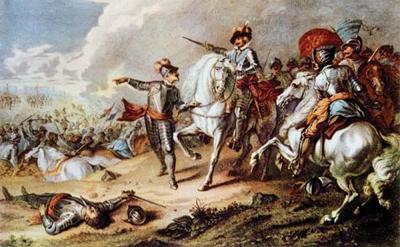Cross-dressing women at the frontline of the English Civil War

A new study by a historian at the University of Southampton has uncovered accounts of women who dressed as men to take their place alongside soldiers during the English Civil War.
Professor of Early Modern History Mark Stoyle investigated claims that the rival armies of King Charles I and Parliament were frequently accompanied by women who dressed in men’s clothing in order to go unnoticed near and on the battlefront.
Professor Stoyle said: “Historians often claim that it was common for women to cross-dress during the Civil War, but in fact we know very little about this subject. Now I’ve unearthed some compelling pieces of evidence which allow us to explore the practice and what people thought about it at the time.”
The research project scrutinised hundreds of original manuscripts and printed works, revealing just a handful of fascinating cases. It shows that the reasons for cross-dressing were varied; some women appear to have been motivated by a desire to fight for the cause alongside male soldiers, while others didn’t want to be parted from their husbands and wore men’s clothes so as to travel incognito.
Charles I’s army in particular was accompanied by a number of female camp-followers made up of wives, unmarried partners (harshly referred to as ‘whores’) and prostitutes, some of whom may have dressed as men to be sexually alluring.
The earliest case in the study is mentioned in an anonymous letter written from Charles I’s camp in July 1642. Later published in a pro-royalist news pamphlet, the letter describes a woman called Nan Ball who was ‘taken in mans cloathes, waiting upon her beloved Lieutenant’ while in the king’s army near York. A top level-investigation was launched, the lieutenant was sacked from his command and it was suggested that the woman should be shamed by whipping or pillory.
Intriguingly though, this harsh suggestion wasn’t acted upon and eventually she was simply expelled from the camp after a letter from the king’s young son begged for her reprieve.
We will probably never know for sure why this woman’s punishment was downgraded after initial stern disapproval. However, at the time, the conduct of the royalist army was governed by formal ‘ordinances of war’ which stated that ‘suspicious and common women’ should be turned away and any officer in their company relieved of his position. So it’s possible that a strong line was initially taken to serve as a warning, while the intervention of the prince later gave the royalist military authorities an excuse to back down and conduct matters by the book.
A year later, in 1643, a draft proclamation was drawn up, setting out required standards of behaviour for Charles I’s army. It included a hand-written memo in the margin from the king himself stating ‘lett no woman presume to counterfeit her sex by wearing mans apparall under payne of the severest punishment’.
Professor Stoyle says the inclusion of this statement is fascinating: “These words suggest the king believed female cross-dressing was quite widespread in his army and show a willingness on his part to take a much firmer line on the practice – particularly in relation to prostitutes. Curiously though, when the proclamation was finally published it contained no reference to cross-dressing.”
Another example featured in the study reveals an encounter between the parliamentarian leader Oliver Cromwell, and the mistress of captured royalist Lord Henry Percy – who was dressed in men’s clothes to hide her identity. Cromwell appears to have been amused by this, getting the woman to sing to test his suspicions that the would-be man was a ‘damsel’.
Despite Cromwell’s worldly-wise attitude and good humour, many parliamentarians would probably have regarded the discovery as proof of the royalists’ immoral and unsoldierly behaviour.
However, the most detailed account of female cross-dressing during the Civil War comes from a pamphlet of 1645, which details the case of a young foot soldier who spent a year in the parliamentary garrison of Gloucester, but was eventually discovered to be a woman when visiting a tailor and ordering a petticoat and waistcoat ‘for my sister’.
The tailor was suspicious and informed the military authorities, who found that this ‘she-soldier’ had originally disguised herself in order to escape the royalists - and later to fight against them.
These examples, and others like them, provide tantalising glimpses of how some bold women chose to pull on the breeches as they navigated their way through a society turned upside down by war. The study, published in The Journal of the Historical Association, History, lifts the veil on female cross-dressing during the Civil War and on contemporary attitudes towards this hidden practice.
